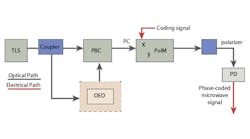Tunable Optoelectronic Oscillators Enable Arbitrary Waveform Generators
With the increased availability of optoelectronic technology, optical techniques for microwave waveform generation have become more and more viable. Using optical methods to generate a microwave signal is attractive, as the limitations of frequency and bandwidth present with traditional microwave waveform generation technologies are not present with optical methods. Recently, researchers Wangzhe Li, Fanqi Kong, and Jianping Yao at the Microwave Photonics Research Laboratory of the University of Ottawa, Canada, developed an arbitrary microwave waveform generation technique using a tunable optoelectronic oscillator.
The goal of the research was to develop a phase-coded or frequency-chirped microwave waveform generator using photonic techniques. To generate the signal, a tunable optoelectronic oscillator (OEO) is used to output a microwave signal and an optical sideband. A polarization modulator (PolM) is then used to modulate the incoming optical sideband and light waves from the OEO laser source. After the application of an electrical signal to the PolM, two complementary phase-coded or frequency-chirped photonic signals are generated. Using a photodetector, these signals are then converted to electrical signals using a high-speed photodiode.
Without using a microwave source, the experimental system was built and verified at 10 GHz and 15 GHz with binary- and polyphase-coded microwave waveforms. Linearly frequency-chirped waveforms were produced with a chirp rate of 20.98 GHz/ns at 10 GHz and 22.5 GHz/ns at 15 GHz.
See “Arbitrary Microwave Waveform Generation Based On A Tunable Optoelectronic Oscillator,” Journal of Lightwave Technology, Dec 2013, p. 3,780.

